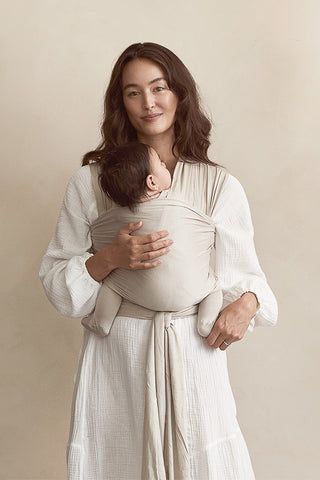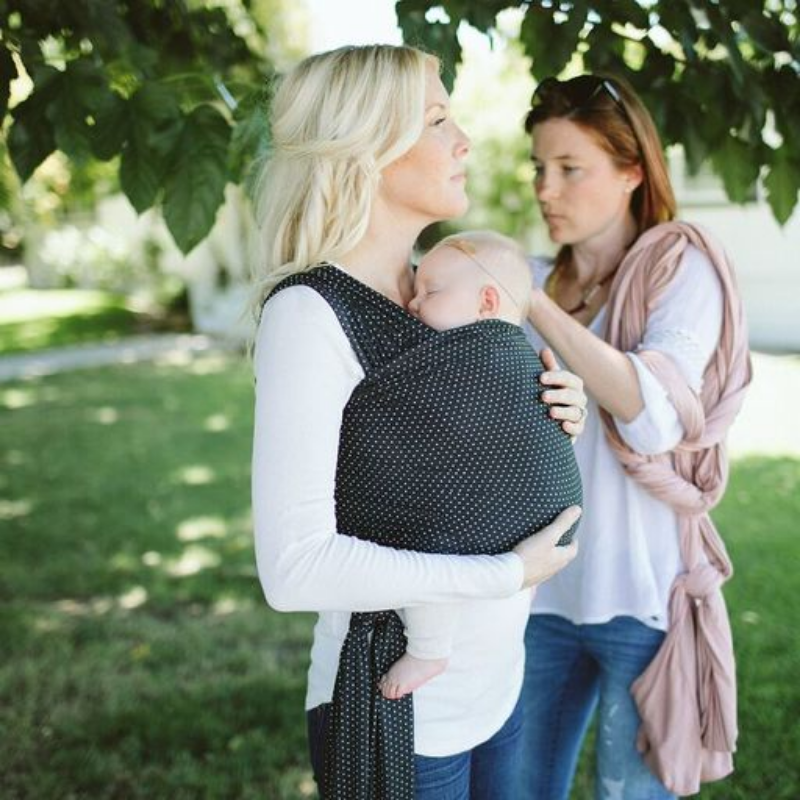If you’ve done any research online, you’ve probably realized that wearing baby forward-facing (sometimes called “world-facing”) in a carrier is a hot topic—and a confusing one, too. Between outdated information, conflicting advice, and marketing that doesn’t always tell the full story, it can be overwhelming to figure out what’s really best for your little one.
At Solly Baby, your baby’s safety and your comfort are always our top priority. That’s why we want to share what you need to know about forward-facing, when it might be appropriate, and why our Solly Wrap and new Solly Soft Carrier are intentionally designed without a forward-facing option.
1. Protecting Baby’s Spine and Hips
Babies are born with naturally curved spines and soft hips that need support. Forward-facing positions can place stress on the spine and hips because:
- Baby’s legs often hang straight instead of resting in a deep, “M-shaped” seated position.
- Weight is unevenly distributed, which can place extra pressure on tiny joints.
Inward-facing carries help maintain proper alignment for healthy hip and spine development.
2. Supporting Head, Neck, and Airway
Young babies need constant support for their head and neck. When facing outward:
- Baby can slump forward or tilt back, which can compromise their airway.
- It’s harder to notice subtle cues of discomfort, fatigue, or overstimulation.
Inward-facing carries naturally let baby rest their head on your chest while keeping airways clear, safe, and visible to you.
3. Reducing Overstimulation
The world is exciting—and overwhelming—for little ones. Forward-facing carries can flood a baby’s senses with sights, sounds, and movement, sometimes causing:
- Fussiness or crying
- Splaying fingers or turning away
- Difficulty sleeping or settling
Facing inward allows baby to observe the world while feeling secure and connected, making it easier for you to respond to their cues and avoid sensory overload.
4. Enhancing Comfort for the Wearer
Forward-facing positions shift baby’s weight away from your center of gravity, which can cause:
- Strain on your back, shoulders, and core
- Increased risk of discomfort or long-term posture issues
- Challenges in maintaining a secure, supported hold
Inward-facing carries keep baby close and centered, making it easier to move comfortably and safely throughout the day.
5. Fostering Bonding and Connection
Babywearing is about more than convenience—it’s about closeness. Inward-facing carries let you:
- Make eye contact and read facial expressions
- Respond immediately to cues like hunger, fussiness, or spit-up
- Enjoy the simple joy of cuddling and connecting
Forward-facing carries, while tempting for curious babies, limit these crucial interactions.
RELATED: A Handy Acronym To Ensure Baby Is Positioned Safely In Your Carrier Every Time
Why the Solly Wrap and Soft Carrier Focus on Inward-Facing
The Solly Wrap—and, in fact, any stretchy wrap—is not designed to be worn with baby forward-facing. That’s because baby and wearer cannot be properly supported in this position, and doing so creates a higher risk of baby falling. We also intentionally designed our new Soft Carrier without a forward-facing option to ensure:
- Maximum support for baby’s spine, hips, and neck
- Safe and clear airways at all times
- Comfortable, balanced weight for the wearer
- Close connection and bonding with your baby
Though the Soft Carrier doesn't offer a front-facing option, it does have a back-carry option, which is a safe and comfortable alternative for wearing curious little ones who want to see the world!
Are other carriers safe for forward-facing?
Baby can be forward-facing in other styles of carriers that have been specifically designed for forward-facing. To do so safely, it’s imperative for baby to have hit all the milestones for forward-facing outlined by the manufacturer. The checklist often includes strong head and neck control (which typically develops around 6+ months), as well as being tall enough that baby’s chin sits above the top of the body panel when facing out.
If you begin wearing baby facing out (in a carrier other than the Solly Wrap or Soft Carrier, of course!), it is recommended to start with shorter stints and monitor baby closely for overstimulation. If baby falls asleep while facing out, they’ll need to be adjusted to face inward toward the wearer to ensure their air passages stay unobstructed and protected.
Questions?
If you’re wondering about forward-facing carries—or need help with positioning, comfort, or milestones—reach out to us at advice@sollybaby.com. We’ll help you find safe, supportive options that work for your baby and your lifestyle.
Babywearing should be safe, comfortable, and joyful for both of you. With the Solly Wrap and Soft Carrier, you can enjoy every snuggle while keeping your little one secure, supported, and close.








